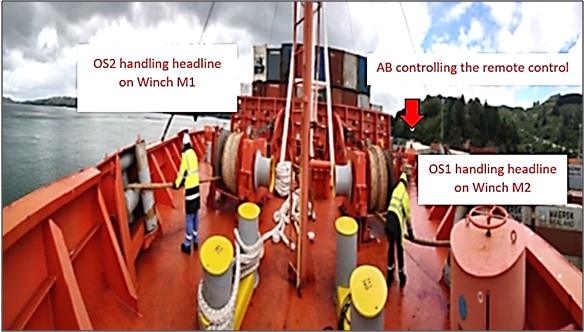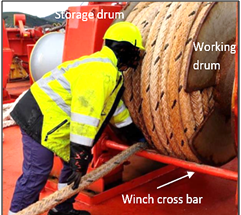An Ordinary Seaman (OS1), sailing for the first time, suffered extensive facial fractures during un-mooring operation whilst the ship was departing from port during daylight hours.

During the un-mooring operation, the forward mooring station was manned by an AB seafarer and two ordinary seamen. There was no deck officer to oversee the un-mooring operation.
In the absence of a supervising deck officer, the AB seafarer was placed in charge of the un-mooring operation and was responsible for operating the mooring winches.

Whilst reeling in the mooring hawser into its storage drum, OS1 who was guiding the headline, was pulled along by the mooring hawser.
As a result, he suffered serious facial injuries when his face impacted on the cross bar. He had to undergo facial reconstructive surgery and treatment to his injured chest and left arm.
Consequently, the ship had to abort its departure and was ordered to anchor for further inspection and investigation.
Findings
- Lack of instruction, leadership, resource planning and risk assessment - There was no responsible deck officer to oversee the task and to provide guidance to the line-handlers, of which one was sailing for the first time. OS1 was positioned very close to the storage drum, reducing his ability to take evasive action in the event of being pulled towards the drum.
- Winch design – the winches were located in a manner which restricts the line of sight between the winch operator and line-handlers. The winch cross bar running across the mooring winch also reduced the clearance available between the storage drum and deck and increased the risk of the rope getting stuck at the bar.
Lessons Learned
Mooring and unmooring are complex operations which are dynamic and require dynamic risk assessments. The incident highlights the importance of having a responsible deck officer to lead the mooring team, one who is not occupied with either the task of line-handling or as a winch operator. In this instance all the deck crew (1 AB + 2 OS) were occupied with line-handling or winch operating. Equipment on board ships must be installed and operated as intended by the manufacturer. Any deviation from the manufacturer’s recommendation may reduce the ability for it to be safely operated.
According to the technical specifications, the rope drum is designed for rope length of 200m and diameter of 64mm, with a stowing capacity of 158m in 6 layers in the storage part and 42m in 4 layers in the working part. The winch storage drum was not able to adequately accommodate the mooring hawser. It is therefore important that technical specifications are complied with.
